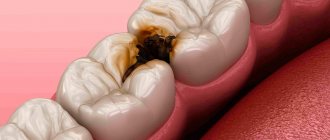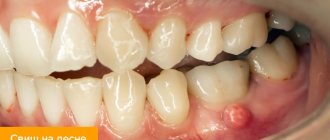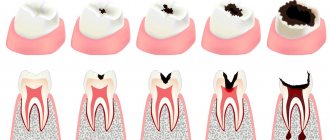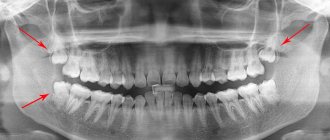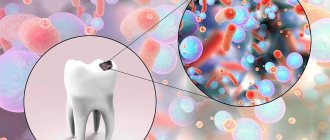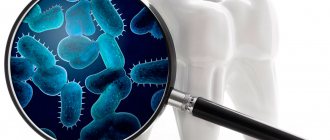When discussing whether caries is dangerous during pregnancy, pregnant women most often have no doubt that the disease negatively affects the baby. However, expectant mothers consider medical intervention even more dangerous, so they often ignore unpleasant symptoms. If treatment is neglected, the disease can progress to an advanced stage, when it is no longer possible to save the teeth, and the entire body is affected by harmful bacteria. Let's look at which diagnostic methods are the safest, and figure out how dentists solve the issue.
Factors causing caries during pregnancy
Women bearing children encounter carious lesions primarily due to exposure to acids produced by pathogenic microorganisms. There is a common belief that oral diseases occur due to calcium and phosphorus deficiency, but this is not true.
The reasons that provoke the problem.
- Hormonal changes. The chemical composition of saliva changes, its protective properties decrease, and the processes of enamel remineralization slow down. She becomes most vulnerable to pathogenic bacteria.
- Poor hygienic care. Expectant mothers, faced with difficulties such as toxicosis or increased fatigue, push hygiene into the background, which leads to the accumulation of dense plaque.
- Poor nutrition. The body does not receive enough of the necessary minerals to maintain healthy teeth.
- Indulgence in high-carbohydrate foods (sweets, flour), sour, carbonated drinks containing sugar contributes to the destruction of the enamel layer.
- Frequent snacks between main meals. Because of this, the acid-base balance worsens.
- Rare visits to the dental clinic. Some women consider the period of bearing a child to be very risky; they are afraid of harming the fetus, so they avoid visiting the doctor. They believe that it is better to endure minor pain than to allow medical intervention. If you do not get rid of the pathology at the initial stage, serious consequences for the mother and baby in the womb are possible.
Causes
The causes of caries developing in pregnant women are:
- weakened immunity;
- hormonal imbalances;
- the presence of systemic diseases, including gastrointestinal and thyroid diseases;
- malnutrition, lack of minerals, vitamins;
- increased sensitivity of teeth to injury;
- changes in the composition of saliva;
- insufficient oral hygiene;
- toxicosis (vomiting causes destruction of enamel).
Why is caries dangerous in pregnant women?
The pathological process is caused by the active growth and reproduction of Actinomyces Naeslundii bacteria. If they are present on the surface of incisors, canines and molars, microorganisms often enter the gastrointestinal tract and blood along with food during meals. The risk of increased uterine tone, dilation of the cervical canal and destruction of the membranes increases.
Thus, any stage of the disease can lead to unplanned premature delivery or miscarriage in the first trimester if measures are not taken in time to eliminate the provoking factors and the teeth are not treated. It is important to stop the destructive activity of pathogens.
How does the process affect the woman and child?
Bacterial flora from the pathological area spreads throughout the body. Pathogens penetrate into the general bloodstream and lead to a deterioration in health. The effect of caries during pregnancy on the fetus is expressed in its abnormal growth and development, and the appearance of congenital anomalies. The baby may be born with various defects and lack of body weight.
Advanced forms of the disease provoke pulpitis and periodontitis. The expectant mother develops characteristic symptoms:
- increase in temperature indicators;
- disorders of the digestive system;
- the appearance or significant increase in the manifestations of toxicosis.
Toothache deserves special attention. This is a painful symptom that leads to psycho-emotional stress and, as a result, negatively affects the course of the gestational process in general and the well-being of the fetus in particular.
Possible complications
Uncomplicated and painless dental caries during early pregnancy does not have any effect on the expectant mother and child. However, in the presence of pain, a woman’s quality of life significantly deteriorates, her emotional state is disrupted, and irritability occurs.
Since hard tissues are destroyed quite quickly, pulpitis or periodontitis often develops. In the absence of timely medical intervention, periostitis of one or both jaws, abscesses, sepsis, phlegmon and other consequences cannot be ruled out.
When infectious and septic complications are observed, the risk of infecting the baby in utero increases significantly. Possible premature birth, endometritis, chorioamnionitis. Ignoring the problem leads to complete or partial destruction of the dental unit and requires its removal followed by prosthetics.
Forms and stages of development of caries
The systematization of various forms of caries is based on several parameters:
- time of detection of pathology;
- specific histological features of the pathological process;
- location and depth of the lesion.
The clinical picture of the disease in pregnant women can be either primary , diagnosed for the first time, or secondary , as a consequence of continued destruction (destruction) of dental tissue with the formation of carious cavities in previously filled teeth.
According to the severity of damage to dental tissues, various types of caries are distinguished: enamel shell, hard dentin tissue, bone tissue, or caries with a suspended destructive process.
To manage pregnant patients, the tactics of topographic systematization of the destructive process are used. There are several stages of development.
Initial stage of caries
Superficial demineralization of the hard structure of teeth is focal in nature, manifesting itself in the form of spots. The formation of white spots characterizes an active destructive process, brown spots - slow destruction. In treatment, the use of minimally invasive techniques is permissible.
Superficial caries
The process of destruction of tooth tissue does not extend beyond the outer protective enamel shell and does not disrupt the structure of the enamel-dentin junction. At this stage of the disease development, the first clinical symptoms appear. Treatment consists of mechanical treatment of the damage.
Average caries
It is characterized by the formation of carious cavities without signs of deep damage to the hard tissues of the tooth, and a pronounced clinical course. The basis of treatment is the removal of damaged tissue.
Deep stage caries
The destructive carious process spreads to the internal tissues of dentin, accompanied by the development of intense pain. Lack of timely treatment threatens pulp damage with a high probability of developing complications in the form of periodontitis or pulpitis.
While carrying a child, women usually develop moderate-intensity caries, which is explained by a decrease in immune defense, a pronounced deficiency of essential minerals, and sometimes a lack of proper dental hygiene. Systemic and multiple formation of carious cavities is rarely diagnosed.
Methods for diagnosing caries during pregnancy
If characteristic symptoms are present, the problem can be diagnosed without much difficulty. The main task of various studies is to search for hidden non-carious pathologies and early detection of severe forms of carious lesions that require urgent medical intervention.
The most informative are the following diagnostic techniques.
- Examination of the oral cavity. Contrasting spots and dark holes are observed on the white surface. The doctor uses a dental mirror and probe and may apply specialized chemical solutions.
- Electrodiagnostics. An excellent alternative to x-rays. Based on information about the strength of the electric current, the specialist calculates the depth of the hole.
- Transillumination. Hard tissues are illuminated with a cold light beam, which makes it possible to distinguish diseased structures from healthy ones.
- Laser diagnostics. The dentist looks at how the beam directed at the destroyed layers of enamel is reflected. A safe and informative method for viewing even the most difficult to reach areas.
At the initial stage, the pathology is differentiated from non-carious diseases. For example, with systemic hypoplasia, fluorosis, acid necrosis, chronic pulpitis. If necessary, the patient is referred for consultation to a maxillofacial surgeon, periodontist and other specialized specialists.
Can X-rays and anesthesia be used?
Does radiation affect pregnancy during caries, how to protect the baby in the womb from harmful effects? Sometimes this method cannot be avoided during therapy, but it is contraindicated during pregnancy. In rare cases, exceptions are possible, but doctors still try not to address them.
Modern equipment used in the Dentika clinic provides minimal radiation doses when using special sensors. If the dentist nevertheless decides to carry out the procedure, the pregnant woman is put on a special lead apron to protect the little person inside. And even with such protective measures, such diagnostics are categorically not recommended.
As for anesthesia, everything is more flexible here. During the gestational period, local agents (external gels and ointments, injections into the gums) are welcome. They are indicated no earlier than from the 14th week, that is, upon completion of the process of formation of the placenta, which protects the baby from external factors.
It is impossible not to treat
The opinion that dental treatment during pregnancy is extremely undesirable and even dangerous is very firmly rooted in society today. However, the obviousness of this misconception can be proven without being a dental specialist. Even initial caries in pregnant women requires a mandatory visit to the dentist. Why? Firstly, the disease progresses several times faster and can turn into pulpitis during pregnancy. Secondly, at an early stage of treatment you can do without the use of anesthesia or x-rays. Thirdly, the expectant mother must be aware that she is not alone now, and the child can receive a genetic predisposition to caries while still in the womb! The rudiments of a baby's baby teeth begin to form already in the sixth week of pregnancy, and in the fifth month their mineralization begins.
Treatment at different times
Having figured out the dangers of caries during pregnancy in mild and severe stages, it becomes obvious that it is impossible to do without high-quality and timely therapy. Most dentists advise urgent treatment of teeth when primary symptoms appear.
Unfortunately, in an “interesting situation” the use of not all medications is permissible. For this reason, the therapeutic regimen should be developed exclusively by a doctor, taking into account the clinical picture, the patient’s condition, her medical history and other prerequisites.
How is caries treated in the first trimester?
This is the most unfavorable time for any medical procedures. The embryo is still very small, it is not protected by the placenta, and is vulnerable to external factors, including diseases of the mother. Obstetricians-gynecologists distinguish 2 main stages:
- From the moment of fertilization to the 3rd gestational week. The baby is sensitive to chemicals and toxins; any treatment can cause a miscarriage.
- Three weeks or later. Human internal organs and systems are formed. The woman suffers from toxicosis, heartburn, and problems with digestive function. Medicines have a bad effect on the development of embryonic structures.
It is better to postpone all events for several months. However, if the process is advanced, severe inflammation has occurred, a steady increase in body temperature and pain is observed, the dentist makes a decision on urgent treatment using the most gentle methods possible, weighing the benefits and possible risks.
How is caries treated in the second trimester?
The likelihood of negative effects on pregnancy is reduced. The expectant mother should closely monitor the condition of her oral cavity, practice daily hygiene and follow preventive measures.
If carious darkening is detected in the initial stages, experts recommend remineralizing therapy. The affected tissues are cleaned of plaque and other deposits, and then covered with special compounds. There is no drill involved, no need to use local anesthesia, and the woman does not experience any discomfort. Subsequently, it is necessary to pay special attention to care procedures and prevent the growth of the affected area.
In advanced cases, filling is performed. Pathological areas are removed, the hole is sealed with composite, ceramic and other materials.
When choosing anesthetics, antibiotics and analgesics, their toxicity is taken into account. In general, the so-called equator of pregnancy is considered the safest time for intervention.
How to treat caries in the third trimester
At the final stage of the gestational process, the baby gains weight very quickly. It puts pressure on the mother's vena cava, which leads to surges in blood pressure, fainting and changes in heart rate.
Before giving birth, a woman should not take a semi-recumbent position for a long time, which also makes therapy almost impossible. Dental diseases themselves do not affect the fetus in any way, but the use of certain medications has an irritating effect on the mucous membranes and the entire body as a whole, and can lead to premature birth.
When the doctor performs certain manipulations, the expectant mother becomes very tired, overtired, and feels fear. This often provokes increased uterine contractions and organ tone.
Treatment cannot be avoided if:
- inflammatory process;
- large affected area;
- pain that cannot be eliminated by rinsing with herbal decoctions and other gentle methods;
- steady increase in temperature.
This condition does not have the best effect on the health of the patient and the fetus. The clinic must ensure the most comfortable position of the woman’s body so that the baby does not put its weight on the vessels (aorta and vena cava) of the expectant mother.
Radical measures (extraction, implantation, prosthetics) are taken after the birth of children. The presence of dental diseases is not an obstacle to natural childbirth. Caesarean section is indicated for obstetric indications not related to the oral cavity.
Can pregnant women have anesthesia?
There are a large number of clinical studies on the safety of local anesthetics in the treatment and extraction of teeth in pregnant women. In Table No. 1, you can see 5 local anesthetics that can be used in pregnant women according to the FDA (corresponding to safety categories B and C). First of all, these are well-known anesthetics such as, for example, Lidocaine or Ultracaine DS, etc. The table also shows the permitted concentrations of vasoconstrictors.
Table No. 1 –
*according to the FDA (Food and Drug Administration, USA)
It should be noted that the use of a vasoconstrictor (vasoconstrictor component) not only allows you to reduce the dose of the administered anesthetic and increase the duration of its action. The presence of a vasoconstrictor makes it possible to reduce the possible systemic toxic effects of the anesthetic. This occurs due to the fact that the vasoconstrictor slows down the entry of the anesthetic into the bloodstream from the injection site, and therefore allows for a reduction in peak concentrations of the anesthetic in the blood (24stoma.ru).
The safety of the use of vasoconstrictors in pregnant women has been shown in many clinical studies (for example, the study by Haas D. “An update on local anesthetics in dentistry”). It is known that vasoconstrictors do not affect uterine blood flow - provided their dosages and anesthesia technique are observed. It is optimal to use the vasoconstrictor epinephrine at a concentration of 1:200,000, and to minimize the systemic effect of epinephrine in pregnant women, it is important to perform an aspiration test during each injection, because it will guarantee the absence of intravascular administration.
How to relieve toothache
If pain suddenly appears due to caries during pregnancy, it is important to visit the clinic as soon as possible. When this cannot be done immediately, it is worth eliminating or at least alleviating the unpleasant symptoms in safe ways. Several effective home methods:
- rinsing the mouth with soda or saline solution, herbal decoctions;
- applying garlic paste wrapped in gauze to the wrists;
- holding a small piece of lard behind the cheek on the side of the diseased unit;
- aloe leaf applied to the site of inflammation;
- plantain juice applied to soft tissues.
From the second trimester, the use of pharmaceutical drugs is permissible. For example, Paracetamol, Kalgel, No-shpa (Drotaverine), Tempalgin show high effectiveness.
But before taking any kind of remedy (including folk remedies), you should consult your doctor. Dentika specialists will compare the benefits and possible harms of using medications, calculate the exact dosages that are safe for the expectant mother and baby, and give other advice on how to prevent negative consequences.
Preventive measures
The risk of developing caries during pregnancy is significantly reduced if you follow simple rules.
- Even during the planning period, cure all diseases of the oral cavity. Holes in teeth must be properly filled.
- Clean at least twice a day. It is better to do this after each meal (you can use a special rinse aid).
- Pay special attention to removing food debris in the interdental spaces using floss, irrigator, or an ordinary toothpick.
- If you are vomiting from early toxicosis in the first trimester, you do not need to immediately run for a brush. It is recommended to rinse your mouth with clean water, wait about half an hour and only then brush your teeth. Otherwise, abrasion of the enamel will occur.
- Try to eat properly so that the body receives a sufficient amount of vitamins, minerals and other valuable components, without which it is impossible to maintain oral health. Deficiency of essential elements also leads to pathologies of fetal growth and development.
- Avoid snacking. It is better to eat a hearty meal, rinse out the food particles, or clean them out in any convenient way.
- Visit the dentist in a timely manner. Treatment of caries during pregnancy at the spot stage is quite quick and painless. If you start a pathological process, you will have to resort to serious methods that pose a danger to the child in the womb.
Dental treatment during menstruation –
There are no special contraindications for dental treatment on such days. However, if your periods are accompanied by increased nervousness, severe weakness, as well as a severe psycho-emotional state, then it is better to postpone dental treatment to more favorable days. Surgical interventions should also be avoided during this period, because starting 2-3 days before the start of menstruation in women, blood clotting decreases, which can lead to bleeding (for example, after tooth extraction).
Blood clotting indicators are fully restored approximately 2 days after the end of menstruation.
Let's sum it up
If a carious lesion is detected during pregnancy, you should not be afraid of dental intervention. Ignoring the problem often leads to the destruction of teeth and their loss. The risk of negative effects on the fetus, premature birth and miscarriage increases. However, not everything is so scary if you consult a specialist at the initial uncomplicated stages of the pathology.
When asked whether caries during pregnancy can be treated for pregnant women both in the early and late stages, doctors give a clear answer - this is a necessary measure to prevent serious complications. Therapeutic and diagnostic methods used in different trimesters may differ slightly.
Tooth decay due to breastfeeding
From night feedings
This practice can cause caries in the baby. Doctors recommend stopping night feedings after six months, as this often leads to the development of early caries. Caries in a mother can also occur during lactation.
Features of treatment
The only contraindication for caries treatment for a breastfeeding mother is severe stress or fatigue . Before the dental procedure, you need to feed the baby and express milk for the next time (preferably). All drugs will be eliminated from the body after 3-6 hours. After treatment, you need to express the milk and pour it out. After this, you can safely continue breastfeeding your baby.
X-rays during breastfeeding are not prohibited, but the use of protective equipment is mandatory. If filling the mother's teeth is safe for the child, then taking antibiotics precludes breastfeeding . Also, dental implantation cannot be performed during lactation.
Possibility of using anesthesia
Pain relief during breastfeeding is relatively safe. For pain relief during breastfeeding, mepivacaine, lidocaine, and ultracaine are used.
